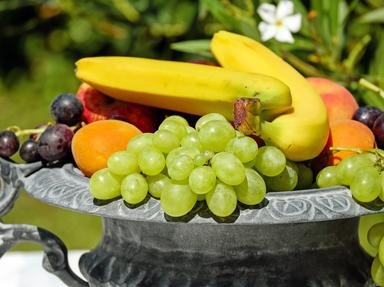Quiz Answer Key and Fun Facts
1. Holding out a bag of the fruit, he says: "Here, try some! This Chinese gooseberry is a lovely fruit. Great by itself or on a pavlova. It is full of Vitamin C." What is it?
2. "Here's another special fruit for you. I think it is looks like a tree tomato, except it isn't. It is called the kaki. This one is a non-astringent variety so it can be eaten without bletting first. Do you want some?" What are you being offered?
3. "Here! Have some pears. These are alligator pears. Unlike many fruit, it is low in sugar but high in fats. It is very popular with my vegetarian customers!" What are you being offered?
4. "Ah, you are back again! I have something special for you this time. These are Japanese plums. Would you like to try one?" He hands you a downy yellow-orange cherry-sized fruit. What is this?
5. Holding out another bag of fruit, our intrepid stall holder launches into another spiel: "Ah, now this one is the tree tomato. It comes from South America originally so I am not sure why it is also called a Dutch eggplant. It is full of pectin and therefore great for making jams and chutneys. Lovely fresh, it is also great when cooked." Which of the following is another common name for this fruit?
6. Oh, oh! What's he got now? Our energetic stall holder holds up some papery lanterns: "These lanterns contain a wonderful marble-sized fruit called an Inca berry or ground cherry. You'll love them on your cereal or to just pop them in your mouth." What have we got here?
7. Here he goes again: "Has anything embarrassing happened recently? These fruit will help to cover it up", he says laughing. "No, really, they are good eating. They are great halved and grilled with a dab of honey and some blue cheese." Ignoring that he has got the reference a bit wrong, what fruit is he on about?
8. Oops! I find myself back in front of the fruit stall. I notice that he is selling some nuts as well. He sees me looking: "Do you like nuts? These are bush nuts. Great for eating by themselves or dipped in chocolate. The shell is very tough so you will need a good nutcracker." What kind of nut are you being offered?
9. My friendly stall keeper is dealing with another customer. As I wait, I notice a small potted bush for sale with some nice berries on it. The label 'Ribes nigrum' doesn't really help me. What is he selling?
10. "You'll like these. Great in pies, jams and even drinks. It is an old favourite. There is even a nursery rhyme mentioning it. How does it go? 'Here we go round ...' or something like that." Now what is he trying to sell you?
Source: Author
suomy
This quiz was reviewed by FunTrivia editor
WesleyCrusher before going online.
Any errors found in FunTrivia content are routinely corrected through our feedback system.

